
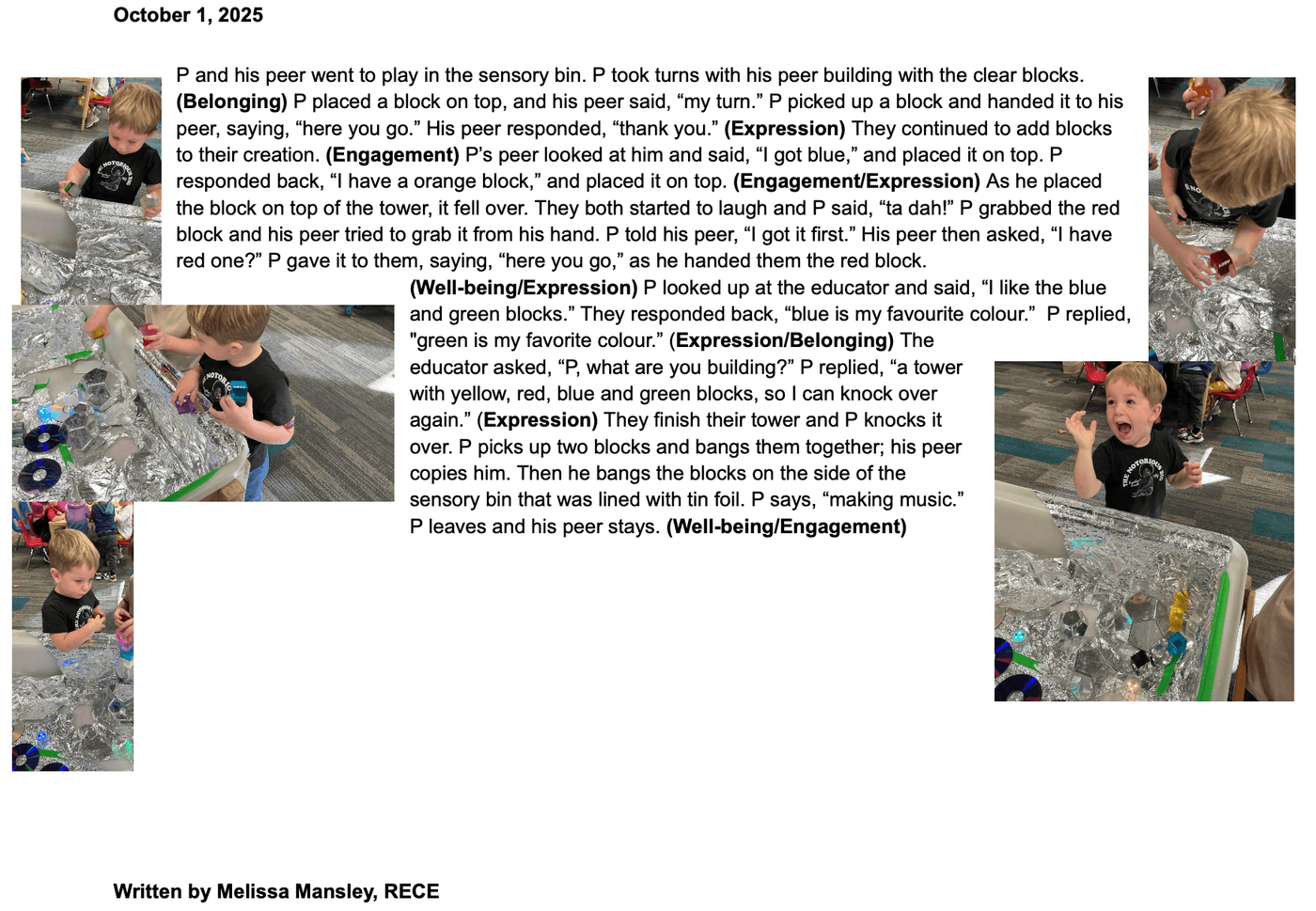

June 2, 2025
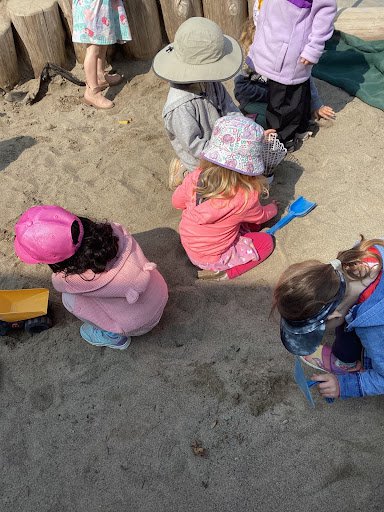
As the weather warms up, the children have had more opportunities to enjoy the sandbox since the sun dries up the sand. The children have been adjusting to sharing the sand toys and the space in the sandbox. Today, I bagan her play in the sandbox, next to many friends who also had the same interest in playing in the sandbox. Although I started playing with a dump truck she overheard some peers next to her baking. One peer said, “This is how you make the sand flat to make cupcakes.” I heard this and used her raking tool to flatten her sand. Then her peer said, “Then you scoop it into here and shake it like this and then make your cupcakes.” Another peer said, “Can I have a turn when you’re done with that one?” and her friend said, “Yeah, you can.” Listening to the children taking turns, I decided to pick up her dump truck and look for a shovel instead of the rake and followed her friend’s instructions for making cupcakes. She scooped some sand, shook the shovel a bit to flatten it and then poured it into the back of the dump truck. She did this many times while her other peers continued to make cupcakes. Then one of the other friends said, “Can I have a turn with that shovel?” and the other friend said, “Yeah,” paused for a bit and said, “Do you want to make carrot cake with me too, over here?” Her peer said, “Okay!” The children were using the materials in a positive manner and sharing them as well. They did not require any educator assistance with communication and turn taking during their time in the sandbox.
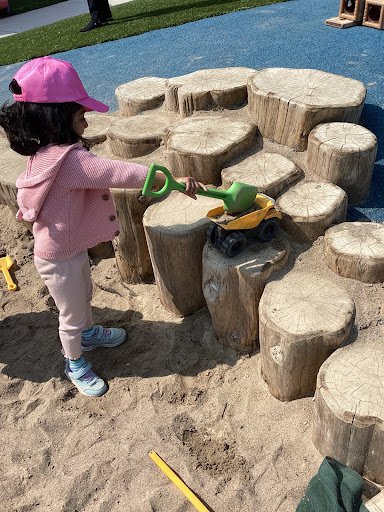
BELONGING: I was participating in a way she felt comfortable as she improves her social interactions in our class. She participated in parallel play as she observed and listened to other peers’ conversations.
ENGAGEMENT: She focussed her attention on the sand and how to manipulate it with her shovel, the rake and the dump truck. She used her hands to level it out once it was in the dump truck.
WELL-BEING: I showed autonomy as she made her own decisions independently. She listened to steps her peers took and tried following most of the steps. Instead of doing peer to peer interactions, where she could have asked for a turn with other sandbox materials, she problem-solved by using the materials she had at hand. She was able to fully enjoy the sandbox play just like her peers did.
EXPRESSION: She showed the ability to listen and follow steps that her peers used which will support later reading and writing.
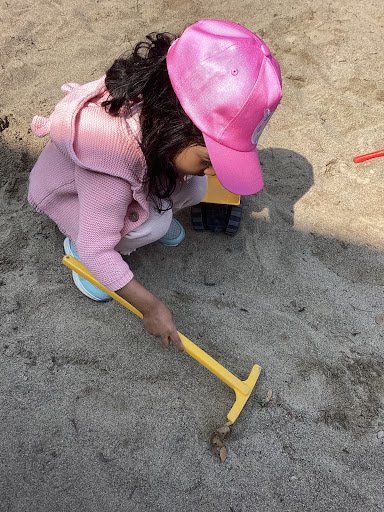
May 5, 2025

H went to the shelf and grabbed the dinosaur bin and took it over to the projector. He took one of the dinosaurs out of the bin and placed it on the projector. He turned on the projector and looked up at the shadow on the wall and said, “big dinosaur is walking,” as he made the dinosaur walk across the projector. H yelled across the room at his peer, asking, “do you want to play at the projector with me?” His peer said, “yes,” with a big smile on his face. H and his peer made big roaring sounds as they played with the dinosaurs on the projector. When H's peer took his dinosaur, he said, “that is mine,” and handed them another one. His peer smiled and took the dinosaur and handed H back his. The educator praised H for using his words and giving his peer another dinosaur to play with. He handed them a Tyrannosaurus Rex. He looked up at the educator and asked, “what is this dinosaur called?” The educator said, “Tyrannosaurus Rex.” H repeated it back. H was holding two long neck dinosaurs and said, “has long neck.” He held them both up and said, “ two same, one smaller and one bigger,” to his peer. They said, “yes.” All of a sudden H's peer was coming towards him with the Tyrannosaurus Rex and H said, “don't eat my baby!” H picked up another dinosaur out of the bin and placed it onto the projector. He said, “look! Dino shadow on wall,” as he pointed to the shadow. H’s peer placed theirs on the projector and H said, “mine is bigger dino than yours.” H picked up three dinosaurs and counted as he placed them onto the projector, saying, “1,2, 3. I have three dinosaur.” As he placed the third one down he noticed something on its belly. He said, “this one has a button, see?” and showed his peer and educator the button. His peer said, “dinosaur has a belly button.” H pointed to his belly and said, “I have a belly button, too!” Then he asked his peer, “want to read a book about dinosaurs?” His peer replied, “H read a book,” and H responded “ok, let's read a book about dinosaurs,” as he and his peer walked over to the book center. They picked a book with dinosaurs on it and sat on the couch together. He and his peer roared at each other. His peer got up and left. H turned the pages of the book and used his finger to follow the words on each page and made up words as he read. H closed the book, saying, “book done.”
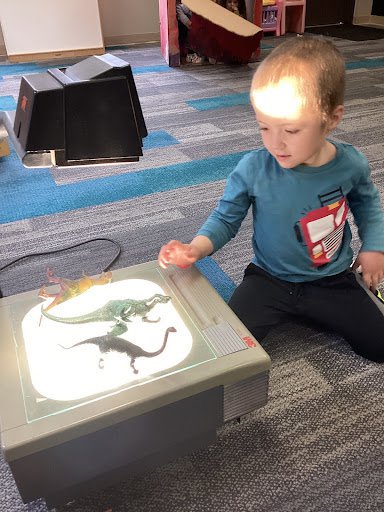
Belonging: H noticed that his peers' dinosaur was smaller than his and said, “mine is bigger dino than yours.” He sought out others to play with by inviting his friend to play dinosaurs at the projector with him.
Well-Being: H was able to regulate and identify his emotions and come up with a solution to the problem. When H's peer took his dinosaur, he said, “that is mine,” and handed them another one. H’s peer said the dino had a belly button and H pointed to his belly and said, “I have a belly button, too,” developing a sense of self.
Engagement: H focused his attention on carefully placing the dinosaurs on the projector to see the shadow on the screen. H and his peers created and represented ideas of the world around them through play when H and his peer pretended the dinosaurs were alive, roaring at each other, stomping and walking.
Expression: H turned the pages of the book and used his finger to follow the words on each page. This will support H later in reading and writing. H looked at the educator and said, “what is this dinosaur called?” When the educator responded “Tyrannosaurus Rex,” H repeated “Tyrannosaurus Rex” learning the name of the dinosaur he was playing with.
By Melissa Mansley, RECE
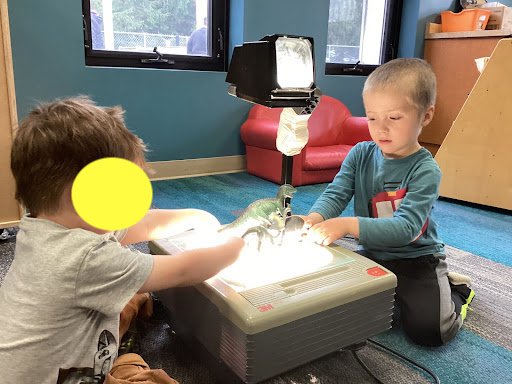
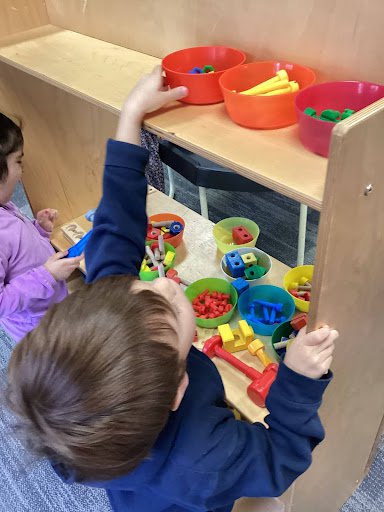
April 1, 2025
After watching his friends play in the dramatic play area, P made his way over to the workshop and started to take out some nuts and bolts and a hammer and placed them onto the table. P looked up on the top of the stand and saw green screws in a bowl. He said, “up there,” and brought the bowl down onto the table. P grabbed a green screw and started hammering it, saying, “get nail in.” His peer joined him. They started pushing him and took his bowl with green screws. P started to cry and then said in a firm voice, “hey, give it back, that is mine!” and his peer gave it back. He continued to hammer but the screw was not going down into the block. P said, “not working.” He took a screwdriver and started to turn the screw and the screw started to go down. P smiled and said, “it is working,” pointing at the screw going down. He turned to his peer and said, “me and dad play nails home.” The peer said, “me too.” P picked up a red screw and said, “red.” He grabbed another red screw and said to his peer, “look it,” putting the two screws together. P looked over at his peer and they were putting blue screws into a holder. He pointed at the holder and said, “can I have it?” His peer says, “sure,” and passes the wooden holder with blue screws. P grabbed the bowls with the different colored screws and put it on the top of the stand. He said “green, yellow and red,” as he placed them up. P hands his peer a green screw, saying, “here go.” His peer replies back, “thank you.” P sees a bowl of yellow screws up high and brings it down, grabbing a screw. He gets the yellow block again and puts the yellow screw in the hole. He grabs The hammer and starts hammering the yellow screw. The screw keeps moving so P grabbed the screw with his right hand to hold it in place when he was hammering it. P said, “stay,” as he looked at the screw but it fell out and he said, “oh no, fall down.” He picks it up and puts the screw back into the bowl.
Belonging- P participated in ways that were comfortable to him. P took time to observe his peers from afar playing at the workshop before approaching it when he was ready. P made a connection between daycare and home when he said, “me and dad play nails home.”
Well-Being/Expression- P was able to regulate his emotions by using his words to communicate when his peer pushed him and took his green bowl of screws. He started to cry then used his words to communicate, saying, “hey, give it back, that is mine!” P participated in meaningful communication with his peer by asking for different screws back and forth in conversation between each other.
Engagement- P created and represented ideas of the world around them through play, as he played in the dramatic play hammering and screwing in screws into a block of wood. He engaged with his peer to negotiate and collaborate by sharing the different coloured screws with his peer and took turns using the screwdriver and then the other one would use the hammer.
By Melissa Mansley, RECE

March 5, 2025

It was time to go to the washroom. The children were all lined up and were ready to go. A was at the back of the classroom. The educator asked him if he wanted to go with R, he replied, “noooo!” in a loud voice. The educators then said to the other children to grab a partner. The educator said, “come A, and grab E’s hand.” A then wandered slowly up to the front of the classroom. His peer was at the back of the line and walked over to A and stuck out their hand. He grabbed their hand and walked down the hallway. The educator praised A by saying, “I like the way you are walking to the washroom with your peer.” He turned and looked at all the classroom doors as he passed by. A walked past the office and looked in, saying, “hi,” in a low voice. They got to the water fountain and he pulled his peer towards it and said, “water.” A pushed the button on the water fountain and water came out. He said, “water,” again. His peer pushed the button too. They both walked into the washroom.
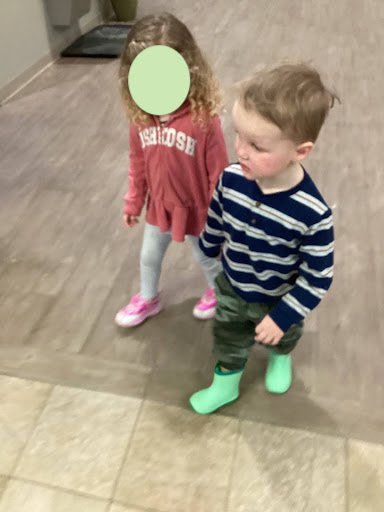
It was time to leave the bathroom. This time A walked up to his peer on his own and said, “hold A's hand,” and grabbed their hand. They headed out the washroom doors and as they walked by the fountain this time his peer pushed the button and he watched. They went by the strollers and A stuck out his hand to touch them. His peer pulled him by hand and said, “come.” A walked all the way back to the classroom. The educator praised A and said, “great job A, you walked all the way to the washroom and back all by yourself. I am proud of you.” A smiled and gave the educator a hug.
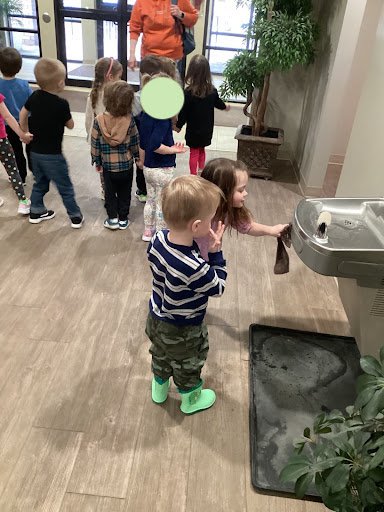
BELONGING: When A got back from the bathroom he gave the educator a hug. This shows that he felt safe in the classroom. A was given the opportunity to walk by himself to the washroom, a goal that the educators have been working with him to accomplish. This shows that he is viewed as capable and competent by his educators. A approached a peer on his own and asked them to hold his hand so he could walk with them back to the classroom. This shows a social interaction between A and his peer.
WELL-BEING: A, showing a sense of competency, walked all the way to the washroom and back without running off. As this is one of his learning goals, it shows an increase in his ability to regulate and follow routine. He showed a sense of autonomy when he decided to walk holding on to his peers hand instead of refusing to walk or falling to the ground. He also knew what friend he wanted to walk with.
ENGAGEMENT: A was able to manage the transition on his own holding onto a peer’s hand to the bathroom and back. He did it with persistence and enthusiasm. He expressed joy when the educator said what a great job he did walking to the bathroom and back and responded with a smile and a hug.
EXPRESSION: A participated in meaningful interaction and communication with his peer when he went up to his peer and said, “hold A’s hand,” and then grabbed his hand.
By Melissa Mansley, RECE
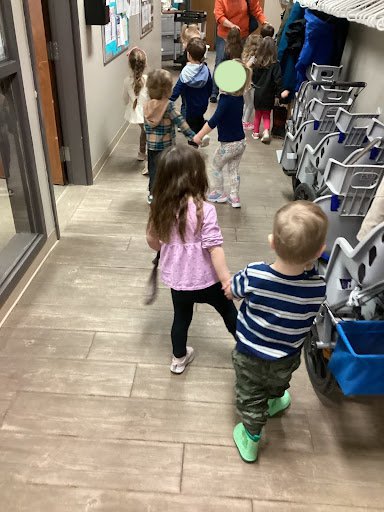
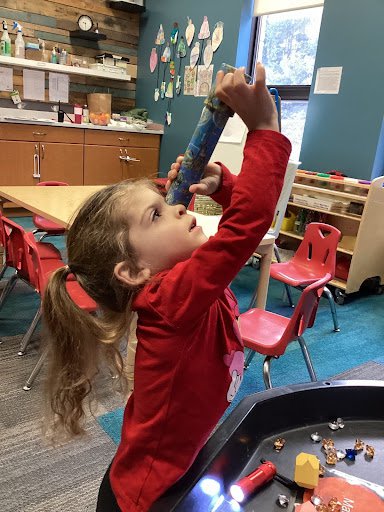
February 11, 2025
When B walked into the classroom she saw the space provocation on the tuff tray. She turned to her peer and said, “look,” as she pointed to the tuff tray. At free time she went to look at what was on the tuff tray. She picked up the kaleidoscope and looked up towards the light. She said, “red, blue, yellow,” as she was looking in. She brought it down and started to turn the end of it and put it back up to the light. B turned the end of the kaleidoscope this time, and said, “I did it.” The educator responded with, “great job.” B turned the kaleidoscope upside down and said, “I see star,” as she looked at the end of the kaleidoscope. B picked up the model space car between her finger and thumb and started moving and driving the car on the moon while making “vroom” noises for the car. She looked around and found the astronaut, picked it up and said to the educator, “look, I find.” The educator asked, “what is that?" B in a low voice said what sounded like, “astronaut.” The educator said, “you're right, it is an astronaut,” and she smiled. B found the space car and placed the astronaut on the car as if they were driving it and made “vroom” noises by bringing her lips together. She walked over to the other side of the table and found the space monkey. As she picked it up to bring it to the space car, she said, “who-ah-ah,” making monkey noises. With the monkey in her hand, she walked over to the space car and tried to put the monkey on the car. It kept falling off and when B finally got it to stay, she had a great big smile on her face. She grabbed the kaleidoscope and knocked the astronaut and monkey off the car and responded, “fall down.” Her peer grabbed her space car and monkey and B said, “no mine.” Her peer replied, “sorry,” and B gave her peer a hug and the carn with a smile. Next, she and her peer played with the gems. B put the gems on Mars, saying, “rocks.” She shone the flashlight on them and as she did this, the button fell off the flashlight. She tried to put it on. The fourth time she turned to the educator and said, ”help,” and handed the flashlight to them. The educator asked B, “do you need me to help you fix the flashlight?” She responded, “yeah.” The educator handed her back the flashlight. B picked up the rocks and dropped them and said, “wow,” as they fell onto the table and the floor. She cleaned them up and walked away.
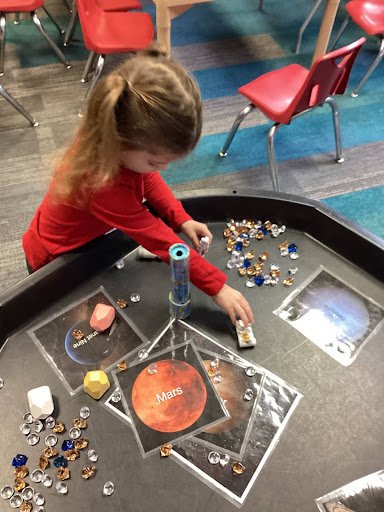
BELONGING: B felt included and safe participating in ways that were comfortable to her at the tuff tray. She took turns playing with the flashlight with her peers. B looked to the educator for support when she asked for help when she could not fix the flashlight.
ENGAGEMENT: B focussed her attention as she placed the space monkey onto the space car precisely so it didn't fall off. She created and represented ideas of the world around her through play as she manipulated the space car driving it to, and all around the moon on the tuff tray. She also used the gems to represent rocks on Mars.
WELL-BEING: B showed a sense of competency and increased coordination when she looked up into the light and turned the end of the kaleidoscope at the same time and said, “I did it.” B showed a sense of agency, recognizing that she had the right to make the choice to go to the tuff tray where the space provocation was and she decided to play with the items that she wanted to play with, showing she is capable of initiating her own play.
EXPRESSION: B started and continued a conversation with her peer when her peer grabbed her car and monkey she was playing with and said, “no mine.” Her peer responded, “sorry,” and B gave her a hug and the car. She developed abilities that will support later reading and writing when she picked up the car between her thumb and finger, practicing her pincer grasp and dexterity that will help her when she is holding on to a pencil and writing.
Written by Melissa Mansley, RECE

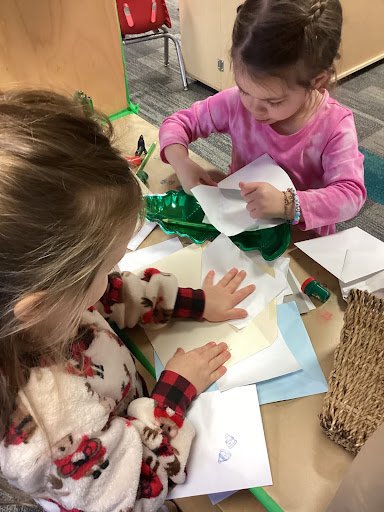
January 6, 2025
A approached the mailing station in curiosity while observing another peer in play. She was attempting to place a piece of paper in an envelope and appeared to be struggling. Her peer picked up a piece of paper and began placing it in the envelope saying, “This is how you put it in.” A and her peer continued placing paper in the envelopes and then A said, “I am stamping it!” Her peer said, “Can I have a turn stamping mine?” A handed her the stamp and said, “Here you go.” They continued sharing the stamp and then began using the pencils to write on the outside of the envelope. As A placed her envelopes into the mailbox, her friend pretended to deliver the mail by throwing one envelope at a time in a circular motion next to the post office. After writing on a few envelopes, A decided to move on to another activity.
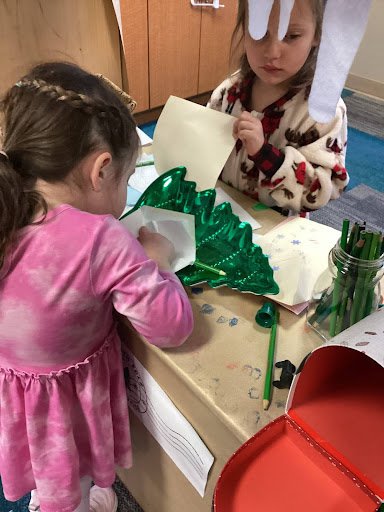
Well-Being: A showed confidence in her growing abilities in fine motor skills, as she accepted her friend’s shared knowledge of how to place the papers into the envelopes and continued to put paper in the envelopes.
Engagement: She was able to focus her attention on her peer’s lesson as she learned a new fine motor skill. A was able to share materials during their dramatic play and collaborate on what happened next.
Belonging: A felt included and safe as she approached the mailing station and her peer included her in play. She was able to maintain social interaction with her friend, as they shared the materials and took turns.
Expression: She wrote information on her envelopes as they prepared them for delivery. This will support A in future reading and writing skills.

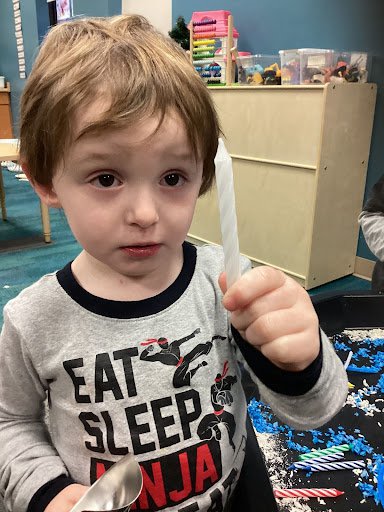
December 4, 2024
This week in exploring how other cultures celebrate, we had a focus on Hanukkah. The colours for Hanukkah are white and blue so right away K’s interest peaked because he loves all things blue. He made his way to the tuff tray and said, “Blue!” He excitedly started scooping up the blue rice and slowly pouring it back into the tray. Soon he discovered a candle. He held it up to the teacher and said, “White.” His educator responded, “Yes, that's a white candle.” Suddenly, one of his peers grabbed the white candle from his hand. “Oh no," he said, putting his face in his hands. An educator guided him to ask for it back. “Please have it back,” he said to his friend. His friend kindly gave back the candle and K said, “Thank you.” His educator praised him for using his words. He proudly said, “words,” and smiled at his educator. Then he continued playing happily until it was time to clean up.
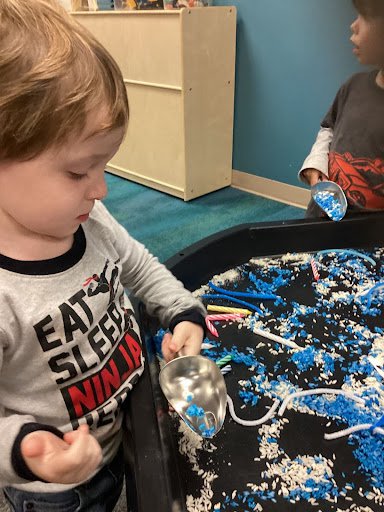
BELONGING: He had a number of social interactions with his educators and friends while playing at the tuff tray. He was very concerned when his friend took the candle he was playing with. He was relieved when he asked, “please have it back?” and his friend gave it back.
ENGAGEMENT: He focused as he played carefully with the blue rice in the tuff tray. He liked the sound of the rice hitting the tray when he poured it out slowly. He was able to work with the educator to get his candle back when a peer took it from his hands.
WELL-BEING: He was able to manage the stress he felt when his friend took the candle he was using. With his educators' help he was able to ask for it back and manage his big feelings.
EXPRESSION: He was able to express himself through reciprocal conversation with his educator and one of his peers. He was able to express what he wanted to his friend and have him return the candle he took.
By Brianna Wall



